My regular winter pilgrimages to my SoDak Winter Raptor Hotspot centered in the Pierre, South Dakota area take me about 250 miles southwest of home, where the winter weather is warmer and the prey base abundant enough to attract an interesting diversity and abundance of birds of prey. After years of observations and exploring I found that this “winter raptor hotspot” hosts the northern-most concentration of wintering raptors in the Great Plains, and periodically I identify and count all the birds along a series of transects that provide occasional excellent photo opportunities.
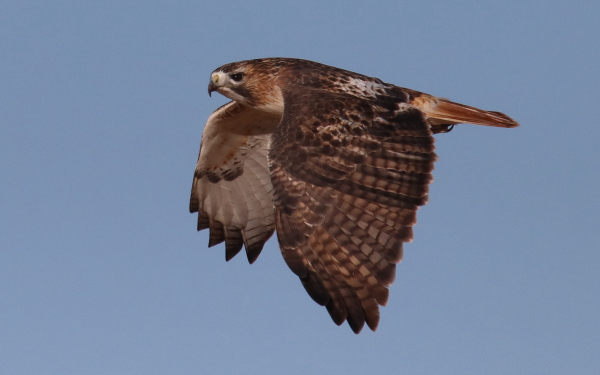
What makes photos “excellent” is the positioning, closeness, and photo quality, but the species of the bird is likewise important. For me, I most appreciate photographing Prairie Falcons, Golden Eagles, Ferruginous Hawks, and Merlins, along with dark-morph Rough-legged Hawks; and very very rarely, I get a chance to take a documentary photo of a wintering Gyrfalcon in the area. That said, although most of these species were present, none of the individuals of these kinds of raptors availed themselves for quality photographs last week. However, I did have some good luck photographing a few more common North American hawks.
I must admit that during my SoDak raptor trips I often pass by Red-tailed Hawks in favor of concentrating my time on photographing other birds of prey. But last week, photo ops were hard to come by and I began trying to photograph all the birds along the way, and that turned out to be almost exclusively Red-tailed Hawks. Partly for the purposes of this article, because I’ve been thinking about this topic recently, I thought that even though I have many many photos of Red-tails, why not take advantage of an opportunity to “practice” photographing them – practice my timing, practice framing the birds in flight, while providing a little piece of mind that my camera and lens settings were just right and ready for the season’s photo activities.
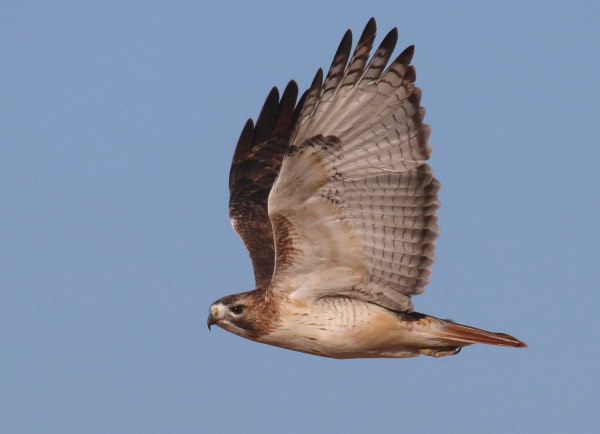
In the end, it was definitely worthwhile and it provided a level of excitement that was missing before the Red-tails were present along southern transect locations. One Red-tail in particular even attracted my attention a second time. This was a hawk that is especially rare in the Dakotas – a light morph Harlan’s Red-tailed Hawk. Harlan’s are always rare in my world, and most of the Harlan’s that make it as far east as the Great Plains tend to be dark-morph individuals. This is one of the only light morph Harlan’s I encounter, and it’s especially interesting because I see it regularly – winter after winter – along the same stretch of a gravel road south of Pierre.
This light morph Harlan’s has also been exceptionally hard to photograph in the past; I have a few documentary photos, but I really wanted to get some good photos of it flying that show its plumage clearly. As I drove down the road where I usually encounter the light morph Harlan’s, I could see it perched on the edge of a roadside cottonwood tree, and before I was very close, the bird took flight – as usual. But this time, after years of it flying straight away at a distance, the hawk banked into a circle, showing its backside, then flaring dramatically into the sunlight to show its underside in stunning spread-feather detail.
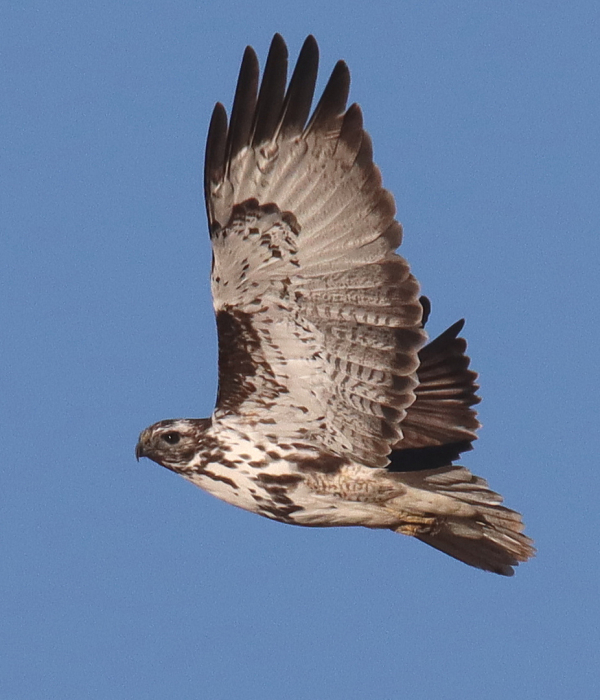
I must admit I was taken aback a bit, and the brief episode left me excited for more, so as I continued on my way, I could see the hawk settle onto another perch near the road, and I imagined my interest to get other images of this bird would bring me back this way again before the afternoon was over. In the meantime, along this southern area of my drive, more Red-tails appeared, and I photographed them too – partly with the idea of “practicing.” During prime afternoon light, I found that when I stopped my car, most of the Red-tails took flight, but circled back past my position, often perching a short distance behind me. That meant that as the hawks passed me, they were flying closer with full sunlight illuminating them – providing natural colors and fast shutter speeds that stopped the motion of their wings and provided sharp details of the birds, including their eyes and hooked beaks.
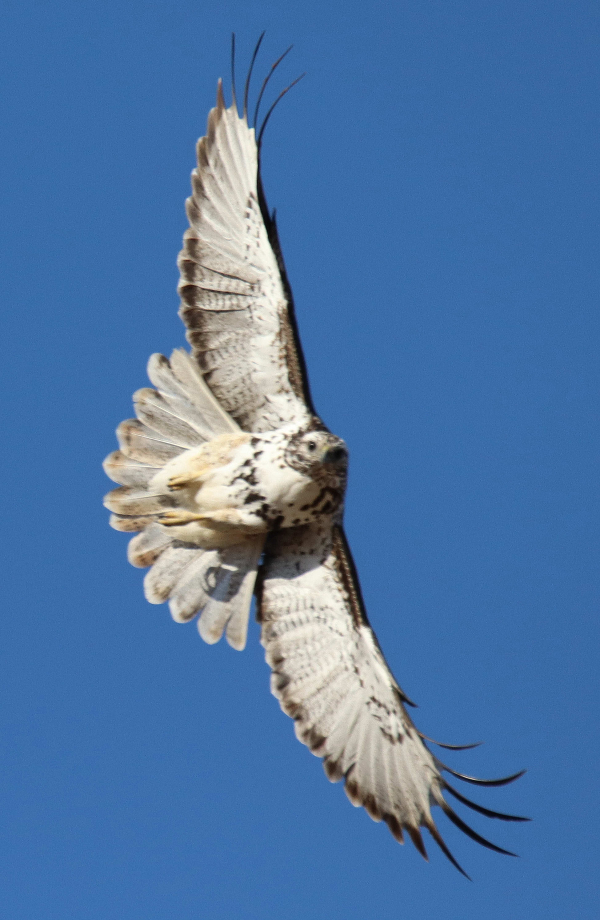
Banking into a circular flight, the light morph Harlan’s Red-tailed Hawk showed its backside, then flared dramatically into the sunlight to show its underside in stunning spread-feather detail (aperture f-7, shutter speed 1/1600, ISO 400).
|
By practicing, I found I became more relaxed each time I photographed one of the hawks, which is rarely the case for me. I tend to get quite tensed up under exciting photo conditions, especially during quick flight photo opportunities. And let’s face it, it’s not easy to keep a flying bird in relatively close position within the photo frame of your camera viewfinder. The closer the bird is, the harder it is to follow its progress within your photo frame as you swing your camera and lens as smoothly as possible to follow the bird’s movements while trying to hold your breath as you press the shutter button and your heart pounds with excitement – Whoo!
Practicing on more commonly encountered birds, like I did with these Red-tailed Hawks, settled me down to appreciate the experience more, and I experienced better results. It also gave me an impression of what to expect with each of the hawks, as they each acted similarly, so practice definitely improved my actions and reactions, along with many of the resulting photos.
After completing my raptor transects, I worked my way back to the light morph Harlan’s Red-tail. While the tail feathers of Red-tailed Hawks are usually orange, there is some variation including varied orange or red-orange shades, a lighter or whiter base color to the tail feathers, occasionally a dark band near the terminal end of the tail feathers, along with other variations. But Harlan’s tail feathers have especially interesting color qualities that are very attractive, if not unusual. My impression is that each Harlan’s tail is quite unique in its color combinations and patterns, and often there is only a hint of orange coloration.
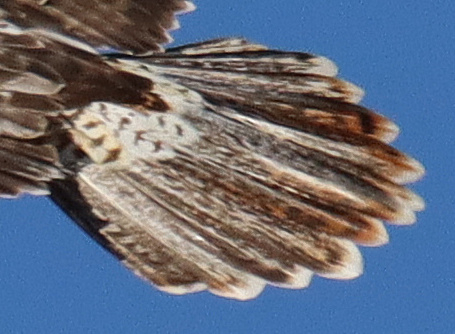
A closer look at the dorsal side of the spread tail feathers of the light morph Harlan’s Redtail show some individual variation among its unique light-colored feathers, with only a few showing hints of orange (aperture f-7, shutter speed 1/2000, ISO 400).
|
So, as I hoped to get more photos of the light morph Harlan’s Redtail Hawk, I also wanted to try to get good images of the bird’s light-colored tail feathers to better view their details. My second meeting with the unusual hawk was brief and less successful, but I did get a couple more photos that included the dorsal side of the spread tail. Later I enlarged an image of the feathers on my computer screen only to realize that each tail feather was quite uniquely marked and colored, which I hope you can see in the attached photograph.
With my initial interest in using the commoner species as practice subjects, I was actually able to get a few of my best photos of a light morph Harlan’s Red-tailed Hawk. But I also managed some quality flight photos of more typical adults and a first-year Red-tail to add to my files of favorite photographs. Realistically, it’s always worth taking advantage of all photo ops considering that we become better photographers through experience, and in some cases through repetition.
Any time I have a bird in my viewfinder’s frame, I’m having fun; plus practicing the art of photographing birds in flight continues to make me a better photographer – you too, I’m sure. Normally, I don’t have the luxury of finding 51 birds of prey in a single day, but in this case it was worth emphasizing the opportunity to practice photographing the commoner birds, which provided with some fine photos as well as valuable experience. As always, good luck as you photograph the birds of December!
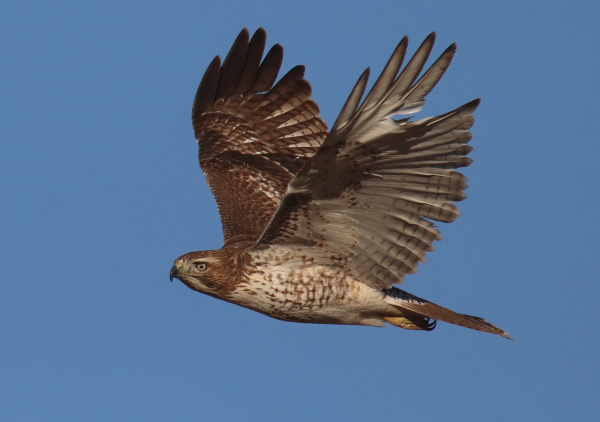
Article and photographs by Paul Konrad
Share your bird photos and birding experiences at editorstbw2@gmail.com